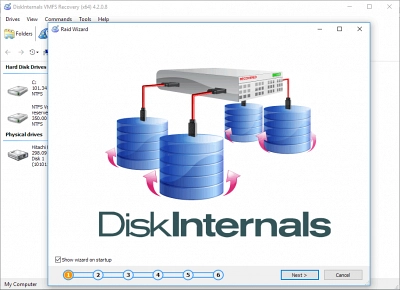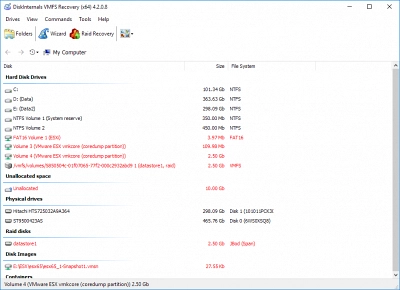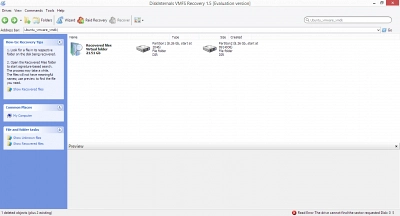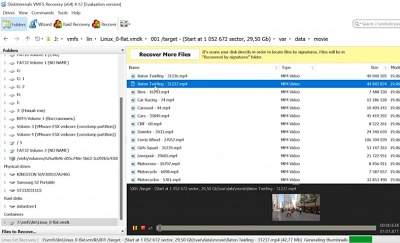How to recover Virtual Disk?
A virtual hard disk drive is represented by the file format known as Virtual Hard Disk (VHD). The only difference between VHDs and physical drives is that, if a VHD is saved in a location other than a physical drive, it cannot be physically touched. VHDs have the same features and properties as physical drives. A boot record, file systems, disk partitions, and folders/files are common components of a VHD file.
VHD files can be directly mounted to a Windows PC running Windows 7 or later versions, despite the fact that they are normally used for logical drives in a virtual machine environment. Data loss happens even if virtual hard drives (VHDs) are stored on non-physical drives and cannot be touched physically since they are susceptible to corruption, accidental deletion, and destruction for a variety of reasons.
In this article you will find out:
- How to Recover Data from Virtual Disk
- What Actually is a Virtual Hard Disk
- Reasons for Data Loss in Virtual Systems
Ready? Let's read!
How to Recover Data from Virtual Disk and How to repair Virtual Disk in VMDK
When a Virtual Disk file is corrupted, it becomes difficult – sometimes impossible – to access the files and data. But then, it is possible to recover VHDX files from virtual disks. However, the process requires the use of a professional virtual data recovery software like DiskInternals VMFS Recovery.
DiskInternals VMFS Recovery stands out from other virtual disk data recovery programs out there because it offers a suite of built-in handy tools and features:
- Designed to clearly read Virtual Disk,
- Recovers information from corrupted or healthy Virtual Disk drives,
- Recovers remotely in online mode (no shutdown is required),
- Recovers VHD drives stored on corrupted and inaccessible hard drives,
- Automated recovery includes step-by-step recovery wizard,
- Virtual drives can be mounted as local disks accessible by Windows Explorer etc,
- Windows restrictions are bypassed by recovery process!
Also, the software can recover your VHD file irrespective of how it got lost – hard drive partition damage, accidental deletion, wrong formatting, or any other scenario.
To get started, download the trial version; this trial version is fully functional and also allows you to preview the recovered Virtual Disk files for FREE
Step 1: Select Your Virtual Disk Drive (The Physical Drive, Actually)

Launch the DiskInternals VMFS Recovery software – the Recovery Wizard will launch automatically too – select the disk where you had saved the VHD file and choose a scanning/recovery mode.
Step 2: Scan The Drive

You may start with the Virtual Disk Fast Recovery mode, which is pretty fast and time-saving. However, if you want to do a wholesome recovery to repair corrupt or damaged files, choose the Full Recovery mode. While the recovery scan is ongoing, DiskInternals VMFS Recovery will automatically examine and structure/fix bad sectors on the disk.
Step 3: Preview and Recover Your Data

Once the scan is complete, the deleted files will be marked with a red asterisk – search carefully and find the VHD file you were looking to recover.

DiskInternals VMFS Recovery lets you preview recovered Virtual Disk files for free, which means you can preview the files you just recovered to figure out the ones that are more important to re-save to your computer.
Part 2: What Actually is a Virtual Hard Disk?
Put simply, a Virtual Disk (abbreviated as VHD) is a computer storage drive you cannot touch physically (if it is not a physical drive where the VHD is saved). A VHD functions like a typical hard disk drive (HDD) or solid-state drive (SSD), but you can’t just remove it or tamper with it physically. Notwithstanding, VHDs can be tampered with – the features and properties can be changed.
Virtual hard disks are used with a virtual machine; so to say, every virtual machine is linked to a virtual hard drive where the virtual machine’s files and important configuration data are stored. VHDs can be formatted with any file system, depending on the purpose. Also, you can install and run operating systems through virtual disks – this shows that a VHD is the same as a physical drive.
A virtual hard disk may be set up to have a flexible or fixed storage capacity; actually, the storage size is controlled by the parent OS or virtualization manager software.
Part 3: Reasons for Data Loss in Virtual Systems (Virtual Disks)
Everything that could cause data loss to a physical HDD or SSD can also cause data loss on virtual hard drives. However, hereunder are some of the most common reasons for data loss on virtual hard drives or disks – whichever you choose to call them.
- Reformatting: If you reformat the VHD (or the physical drive where the VHD is saved), it could lead to data loss.
- Corruption: If the virtual machine files or the VMFS datastore volumes are corrupted, it could lead to data loss.
- Hardware Failures: Hardware failure can occur due to power surges or OS crashes. If the physical hard drive fails, the VHD stored inside will most likely fail too.
- RAID Problems: If the VHD is saved on a RAID array, any problem with the array will lead to the loss of the VHD file.
- Accidental Deletion: The system user may accidentally delete the VHD file.
Conclusion
Conclusively, this article explains how to perform data recovery on Virtual Disks (VHDs). The process is all about installing a powerful data recovery solution or virtual data recovery services, and launching a Full Recovery on the physical drive where the VHD is stored.
FAQ
How do I recover data from a virtual disk?
To recover data from a virtual disk, you can try the following steps:
1. Check the virtual disk: Ensure that the virtual disk is not damaged or corrupted. You can try to mount the virtual disk and see if it is accessible.
2. Use data recovery software: If the virtual disk is recognized but inaccessible, you can try using data recovery software to recover the data. There are several data recovery software options available online that can help recover data from a virtual disk.
3. Create a new virtual disk: If the virtual disk is damaged or corrupted, you may need to create a new virtual disk and try to recover the data from the old virtual disk. You can use disk cloning software to create a copy of the old virtual disk and then attempt data recovery on the cloned disk.
4. Seek professional data recovery services: If the above steps do not work, you may need to seek the help of a professional data recovery service. They have specialized tools and techniques to retrieve data from virtual disks that are severely damaged or corrupted.
What is virtual drive recovery?
Virtual drive recovery is the process of retrieving lost, damaged, or deleted data from a virtual drive. A virtual drive is a type of software-based storage device that emulates a physical drive, such as a hard drive, CD/DVD, or USB drive. Virtual drives are often used in virtualization environments, where multiple virtual machines share the same physical resources.
How do I reset my virtual hard drive?
To reset a virtual hard drive, you can try the following steps:
1. Shut down the virtual machine: Ensure that the virtual machine that uses the virtual hard drive is turned off.
2. Backup your virtual hard drive: It's always a good idea to backup your virtual hard drive before resetting it. You can create a copy of the virtual hard drive file and store it in a safe location.
3. Delete the virtual hard drive: Open your virtualization software, navigate to the virtual hard drive settings, and delete the virtual hard drive. This will remove the virtual hard drive from the virtual machine configuration.
4. Create a new virtual hard drive: Once the old virtual hard drive is deleted, you can create a new virtual hard drive with the same specifications as the old one.
5. Configure the new virtual hard drive: Attach the new virtual hard drive to the virtual machine and configure it according to your needs.
6. Restore data: If you have a backup of the old virtual hard drive, you can restore the data to the new virtual hard drive. Alternatively, you can install a new operating system and software and start using the new virtual hard drive from scratch.
How do I recover data from a crashed virtual machine?
To recover data from a crashed virtual machine, you can try the following steps:
1. Determine the cause of the crash: Identify the reason why the virtual machine crashed. It could be due to a software or hardware failure, corrupted files, or other issues.
2. Restore the virtual machine: Try to restore the virtual machine to a previous state or configuration, using the backup or recovery tools provided by your virtualization software.
3. Mount the virtual disk: If you can't restore the virtual machine, you can try to mount the virtual disk to another virtual machine or physical computer. This will allow you to access the files and folders stored on the virtual disk.
4. Use data recovery software: If the virtual disk is corrupt or damaged, you can use data recovery software to recover the data. There are several data recovery tools available online that are designed to recover data from virtual disks.
5. Seek professional data recovery services: If the above steps do not work, you may need to seek the help of a professional data recovery service. They have specialized tools and techniques to retrieve data from virtual machines that are severely damaged or corrupted.
Can I install the software on any Windows Computer?
DiskInternals VMFS Recovery software has some system requirements that your Windows computer needs to meet before you can install it successfully.
Here are the system requirements for DiskInternals VMFS Recovery software:
- Windows 7 or later operating system
- At least 1 GB of RAM
- At least 50 MB of free disk space
- Administrator rights to install and use the software
If your Windows computer meets these requirements, then you should be able to install DiskInternals VMFS Recovery software without any issues. However, if your computer does not meet these requirements, you may need to upgrade your system before installing the software.
It's also important to note that DiskInternals VMFS Recovery software is designed to recover data from VMware virtual machines running on VMFS file systems. If you are not working with VMFS file systems, this software may not be the best choice for your data recovery needs.
How much time does this tool take to recover files from formatted Virtual Drive?
The time it takes to recover files from a formatted Virtual Drive with DiskInternals VMFS Recovery can vary depending on several factors such as the size of the Virtual Drive, the amount of data stored on the Virtual Drive, the extent of the formatting, and the performance of your computer's hardware.
DiskInternals VMFS Recovery is a powerful tool designed specifically for recovering data from Virtual Machines. It uses advanced algorithms to scan the Virtual Drive and locate lost or deleted files, even from formatted or damaged Virtual Drives.
The recovery time can depend on the complexity of the recovery process and the level of damage to the Virtual Drive. A quick scan can usually be completed within a few minutes, while a deep scan that searches for lost partitions and damaged files may take several hours to complete.
To optimize the recovery time, it's recommended to close any unnecessary applications and avoid using the Virtual Drive until the recovery process is complete. The speed of your computer's processor, the amount of available RAM, and the speed of the Virtual Drive can also affect the recovery time.
My Virtual Drive is not Detected in Virtual Machine, the software can able to recover data from not detacted Virtual Drives files?
If your Virtual Drive is not detected in the Virtual Machine, it's possible that the Virtual Drive has been corrupted or damaged in some way. In such cases, data recovery software like DiskInternals VMFS Recovery can still be able to recover data from the not-detected Virtual Drive.
DiskInternals VMFS Recovery is designed to search for and recover data from damaged, corrupted, or formatted Virtual Drives. It uses advanced scanning algorithms to locate lost, deleted, or damaged files, and can also detect and recover lost partitions.
